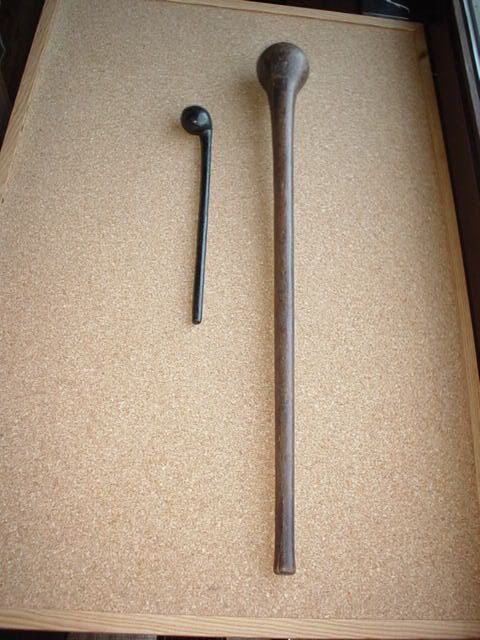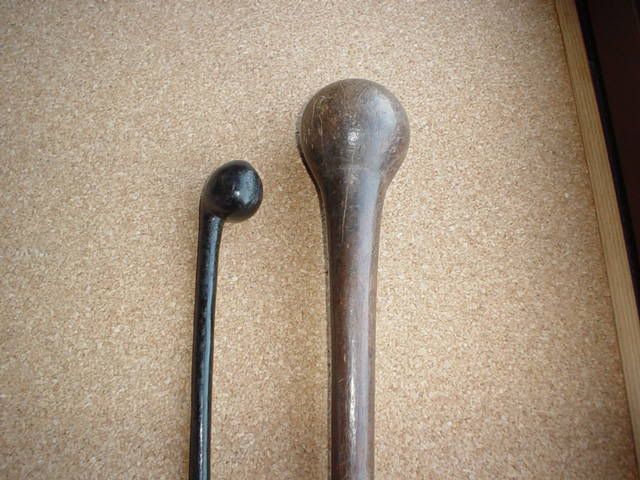
 |
|
|
#1 |
|
Member
Join Date: Dec 2004
Location: What is still UK
Posts: 5,806
|
You cannot say you collect African weapons with out one.Rubbish ones are still made and hawked today.Made through out a huge area of southern Africa.A good one is a pleasure to handle and compared to southern spears an extravagant use of wood.These are my examples, both aprox-69cm long.Somebody out there must have some of the more exciting ones with the carved or off-set heads.I hope to start something off by saying, the ones with brass wire are not Zulu but other people further north like what was Mashonaland.Tim
 
Last edited by Tim Simmons; 8th June 2005 at 07:53 PM. Reason: spelling |
|
|

|
|
|
#2 |
|
Member
Join Date: Dec 2004
Location: Houston, TX, USA
Posts: 1,254
|
Interesting that they are basically the same length and shape, but the one is so much more massive. Closely comparable to Shillelagh (spelling), but then a similarity between Bantu and Celtic would not be the first such seen. Are these purely a southern phenomenon? I've seen very similar clubs attributed to both E Africa and the Congo region, but often can't judge the accuracy of such IDs. Is it true they are made of rootwood? Your one appears to be ebony? The strength of the wood used must be great? Is it true the knobs are scars grown around an iron ring or wire? I would imagine, BTW, that good traditional using ones are still made, too; a decent weapon that a poor man can afford, or even make....
|
|
|

|
|
|
#3 |
|
Member
Join Date: Dec 2004
Location: What is still UK
Posts: 5,806
|
Hi Tom,the heavier one is obviously for knocking your brains out, ouch !
 The lighter one looks like it is made from a different wood, one that takes a finer finnish.It is still very strong and if you had to you could really hurt a person with it, but I think it is rather like when gentlemen carried canes and walking sticks, the quallity reflecting your position in the community.This picture is of Shona people.The knobkerrie here is almost a staff.I will get some more pictures of different ones soon>Tim The lighter one looks like it is made from a different wood, one that takes a finer finnish.It is still very strong and if you had to you could really hurt a person with it, but I think it is rather like when gentlemen carried canes and walking sticks, the quallity reflecting your position in the community.This picture is of Shona people.The knobkerrie here is almost a staff.I will get some more pictures of different ones soon>Tim
Last edited by Tim Simmons; 8th June 2005 at 07:52 PM. |
|
|

|
|
|
#4 |
|
Member
Join Date: Dec 2004
Location: Sint-Amandsberg (near Ghent, Belgium)
Posts: 830
|
African clubs are my favourite collector's items.
A lot of the pieces we find here in Belgium are not Zulu or Swazi. They usually come from Tanzania : Gogo, Masaai, etc... Here are two pieces of my collection : the biggest one and the smallest. To give you an idea. The tall one measures 70 cm and weighs about 0,5 kg. Real heavy ! Perfect for 'knocking one's brains out' as Tim said. The smaller one only measures 31,5 cm and weighs 100 gr. Nevertheless it's well constructed and made of dense wood. It's probably not as deadly as the first, but it would definitively hurt (for a while).  I was told that both are Gogo.  
|
|
|

|
|
|
#5 |
|
(deceased)
Join Date: Dec 2004
Location: East Coast USA
Posts: 3,191
|
I have to agree with Tim and Freddy clubs are one of my favorite things to collect
 it must be the cave man in me or something it must be the cave man in me or something  . Here are a few from my collection. Left to right a large heavy Zulu knobkerrie next is a very nice root burl head one Zulu I think and the others could be Massai? What's your opinion Tim? . Here are a few from my collection. Left to right a large heavy Zulu knobkerrie next is a very nice root burl head one Zulu I think and the others could be Massai? What's your opinion Tim?Lew |
|
|

|
|
|
#6 |
|
Member
Join Date: Feb 2005
Location: Clearwater, Florida
Posts: 371
|
First off, yes, contemporary war clubs are still being made today by native craftsmen for actual use all over Africa and not for the tourist trade, as a gentleman named Gordon Crawford in Swaziland had sent me several photos of a quite elderly carver doing exactly that out in the remote bush.
By the way, these were often used as missles/trowing sticks for hunting small game and fowl as well as for hand-to-hand combat, and some of the lighter ones may well have been made with that in mind, although they are also used in ritual combat and in coming of age rites by many tribes as well, often accompanied by small wooden shields that are almost identical to the Australian aboriginal types that most are familiar with. Of the four shown, (L to R) the two round headed are Zulu, called "Iwisa", while the other two are Swazi and called "Lingedla", decidedly parrot headed in shape and with a depression in the top and bottom that was kept packed with animal fat to prevent splitting when not in use. As you can see, the larger one has beem cut down slightly and I actually use it as a cane, since running is no longer an option!**grin** Surprisingly, it's been admitted to both courthouses and airports and the guards actually told what is is, only to recieve admirable comments and then be returned to me, although it's definitely lethal, far moreso than a baseball bat that was often favored by gangster elements.....apparently, it has to be steel before they realize it's deadly! 
|
|
|

|
|
|
#7 |
|
Member
Join Date: Dec 2004
Location: What is still UK
Posts: 5,806
|
I show these because they display authority to have contact with the spirit world,and as staffs come from weapons.The black one is fairly modern post war I should think,Yoruba Ifa divination priests staff. I also have an ivory tapper but that is a step too far.The other one ,I am not sure of its exact orign though feel it is S or SE Africa.
Lew, I almost forgot.Nice clubs the big one is the DB's  I also really like the small black one.They look southern to me but the smaller ones could be Massi.Tim I also really like the small black one.They look southern to me but the smaller ones could be Massi.Tim
Last edited by Tim Simmons; 9th June 2005 at 07:48 PM. |
|
|

|
|
|
#8 |
|
Member
Join Date: Dec 2004
Location: What is still UK
Posts: 5,806
|
I got this one today.A bit like a baton.Just had to show you all.Tim
Last edited by Tim Simmons; 11th June 2005 at 07:52 PM. Reason: spelling |
|
|

|
|
|
#9 |
|
Member
Join Date: Dec 2004
Location: Singapore
Posts: 1,180
|
Whoa, somehow, these clubs are beautiful... I want one too...

|
|
|

|
 |
|
|